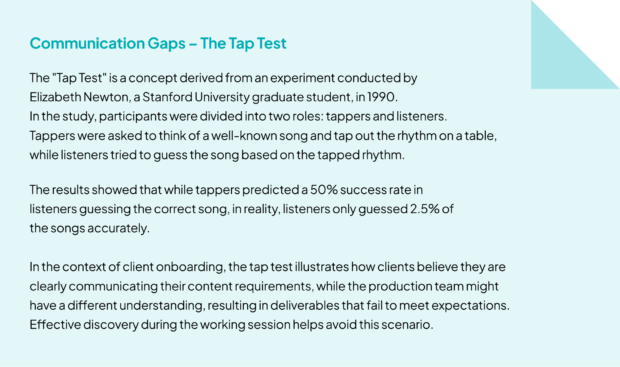
A working session is a crucial meeting that takes place after closing a sale, often serving as the initial point of contact between the production team and the client. The primary objective of a working session is to align the person overseeing production with the client’s vision for the completed content.
During this meeting, participants engage in detailed discussions about the voice, style, structure, and purpose of the content. Project logistics are determined, and all necessary information is gathered to move forward with the calibration phase.
The Importance of Working Sessions
Working sessions are critical to the success of content projects for several reasons:
- Proper alignment achieved during working sessions leads to deliverables that meet the client’s expectations in terms of voice and quality.
- Covering the minutiae during working sessions ensures consistent deliverables from larger teams of remote writers and editors.
- Determining logistics in working sessions results in predictable cadences, on-time deliveries, and smooth, efficient workflows.
Skipping or even cutting corners on a working session can lead to a challenging onboarding process, multiple calibration rounds, delays in full launch, and potential client dissatisfaction. Rather than relying solely on forms or questionnaires, conducting working sessions in person is preferable to facilitate follow-up questions and consulting on issues that might not otherwise come up.

Types of Discovery in Working Sessions
Discovery is a key aspect of working sessions, designed to methodically extract all the important details from the client and compile them in a way that makes sense to writers and editors. This process helps avoid the “tap test” scenario, where the client believes they’ve accurately described their requirements but the delivered content fails to meet their expectations.
During working sessions, various types of discovery take place, including:
- Understanding the client’s goals and objectives for the content
- Identifying the target audience and their needs
- Discussing the desired voice, tone, and style of the content
- Determining the structure and format of the deliverables
- Addressing any specific requirements or preferences for the content
- Gathering necessary information and resources to support the content creation process
While other topics are discussed during the working session, it’s the content discovery process that’s most critical to onboarding and long-term project success.
10 Tips for Conducting Effective Working Sessions
There are many ways to approach a working session, but consider the following tips to help ensure you and your client get the most out of this crucial process.
- Prepare a comprehensive agenda: Before the working session, create a detailed agenda that covers all the essential topics to be discussed. Share the agenda with the client in advance to ensure everyone is on the same page and prepared for the meeting. We’ve created an agenda you can use within our ebook: Guide to Onboarding Clients and Launching Content Projects.
- Assign a dedicated facilitator: Choose a team member to facilitate the working session. The facilitator is responsible for keeping the conversation on track, ensuring all agenda items are covered, and promoting active participation from all attendees.
- Encourage open communication: Foster an environment that encourages open and honest communication. Encourage the client to share their ideas, concerns, and expectations freely, and ensure all team members have the opportunity to contribute to the discussion.
- Use active listening techniques: Practice active listening during the working session. Pay close attention to the client’s input, ask clarifying questions, and rephrase key points to ensure a shared understanding.
- Leverage visual aids: Utilize visual aids, such as presentation decks, to help illustrate concepts and facilitate better understanding. Visual aids can be particularly helpful when discussing complex topics or explaining the content creation process. We’ve included a working session deck you can use in our Guide to Onboarding Clients and Launching Content Projects.
- Handle off-topic questions and stay focused: Be prepared for off-topic questions during working sessions. Address the client’s concerns, but use the working session deck to gently guide the conversation back to the agenda items, ensuring all essential topics are covered.
- Ensure decisions are made: Encourage clients to make definitive decisions during the working session, even on minor points. Consult and advise when they’re unsure to prevent ambiguity that could lead to inconsistencies in deliverables from the writing team.
- Allocate time for questions and feedback: Set aside dedicated time for the client to ask questions and provide feedback. Encourage them to voice any concerns or seek clarification on any aspects of the project.
- Conclude with a clear plan of action: End the working session with a clear plan of action, including pre-production work, calibration start, and deadlines. This helps ensure a smooth transition into the content creation phase.
- Send a working session summary for client sign-off: After the working session, compile a summary of the key points discussed, including the client’s preferences, content requirements, and project logistics. Send this summary to the client for review and sign-off to ensure alignment and minimize misunderstandings.
Working Session Resources
To facilitate effective working sessions and ensure all necessary topics are covered, we’ve developed a set of tools and templates. These resources help keep the conversation on track, minimize the risk of roadblocks and bottlenecks in production, and ensure all decisions made during the working session are summarized and approved by the client.
The resources can be found in the agency resources page on our site or in the full Guide to Onboarding Clients and Launching Content Projects. They include:
- Agenda for General Content Working Session
- Agenda for E-commerce Content Working Session
- Working Session Deck
- Working Session Summary Template